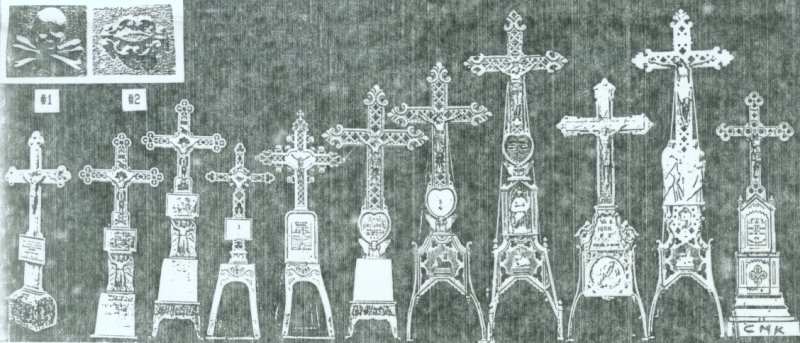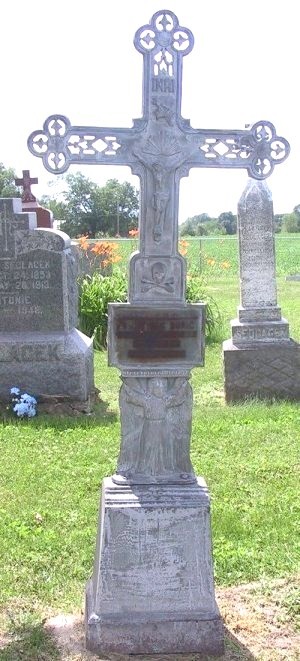|
In addition to his wonderful work, Andera left us with a number of questions: Where did he learn his many skills, where did he have his intricate crosses cast, how did he market them, and how many more are there that we don't know about? Those questions are all begging for answers. An effort is now underway to resolve them and to locate and catalog all of his wonderful grave marker crosses. Andera
came to this country with his parents and several siblings in the early
1860’s from Hrobska Zahradka (Garden of the Graves), a small village
near Tabor, Bohemia. It’s name derived from the ancient burial grounds
near which it was located. After a short stay in Toronto, Canada, the
family settled on a farm near Spillville in Winneshiek County, Iowa.
There in 1875 Charles married Barbara Dostal, the daughter of a wagon
maker. Where he lived in the interim is unknown. Was it perhaps with an
older half-brother near Charles City, Iowa who had trained in Vienna,
Austria as a furniture maker? When the question came up, long after his
death, no one had an answer. Now
a skilled carpenter and cabinet maker, Charles Andera opened a furniture
store next to his small house in Spillville. His work included the
construction of the communion rail and other wooden appointments in
Spillville’s St. Wenceslaus Church. Bells of the clock he installed in
the steeple sounded on the quarter hour and could be heard for miles.
Commuting by bicycle, he crafted the altars in the Catholic churches in
nearby Fort Atkinson and Protivin. He also made burial caskets. The
earliest crosses still in existence in the Spillville cemetery were made
from wagon maker’s strap iron and may have been the product of John
Dostal, Andera’s father-in-law. Was this connection perhaps what gave
Charles Andera his cross-making start? There would have been wooden
crosses of Oak, a common practice which in his native land, went back
several centuries. Charles
Andera sculpted his crosses from wood and Plaster of Paris, then sent
this pattern to a foundry to have them cast. The corpora, of which there
were several sizes, as well as the small statues which adorn two of his
designs, he carved from wood. The inscription plates he may have cast
himself. The foundry was probable in Wisconsin but to date no solid
evidence has been found. Most
puzzling is the question: how did this craftsman locate buyers scattered
throughout such a wide region? Spillville was a village of less than 400
souls, Tremont less than a quarter that size. The sole Andera ad that
has been found was a 25th anniversary history of the Catholic
Workman, a Czech Catholic fraternal union, the Spillville chapter of
which Charles Andera was the founding member. He was a also a charter
member of the Western Czech Catholic Union which was incorporated in
Spillville on 1 January 1899. |
|
|
The Andera grave marker crosses are rich in symbolism. His #1 was adorned with a skull and crossbones. (This did not indicate that the deceased had died from poison as one school child surmised, but was an image commonly displayed by Czech Catholics in centuries past as a reminder of man’s mortality.) This style was also available with an abstract design. Other symbols and decorations that the cross maker utilized included angels, cherubs, crucifixes, the Lamb of God, statues of Jesus and the Virgin Mary, the crown of thorns, quatrefoils, and trefoils. States in which Andera crosses have been found are Iowa, Minnesota, Wisconsin, Michigan, New York, North Dakota, Nebraska, Oklahoma, Kansas, Missouri, and Texas. Shown below are examples of the Charles Anderas crosses. Andera’s photos of the crosses he sold show eight different basic designs which, through markings, can be identified as his work. Each cross could be obtained with a variety of stone or metal bases. Strangely, there appears to be no pattern in the manner in which Andera marked his crosses. Some simply have his intials, “C.A.”; others include his intials or name, the words “Spillville. IA” or “Tremont, MO” and may include the date of manufacture. Some, on the back of the heart shaped inscription plate, are marked “No. 5” or carry the outline of a cross. Many monuments, otherwise indentical to the marked crosses, are unmarked. If
anyone has knowledge about Andera crosses, contact
|
Grave monument of Vojtech
Krall in Sec 46 of the |
 |
|
